Kaffir Bread, Hottentot bread, Mombasa cycad
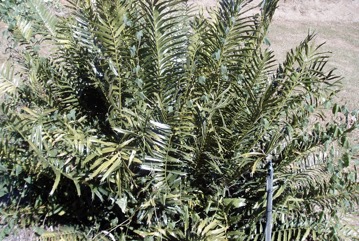
They suit tropical and subtropical climates. They need a sunny position and good drainage. They cannot tolerate frost. It grows in sparse deciduous forests and in grassland. They grow from sea level to 600 m altitude. They grow in regions with hot humid summer climates and mild dry winter climates. These places have a summer rainfall of 1000-1400 mm per year. It suits hardiness zones 10-12.
Also known as:
Balacha, Icheli, Mgwede, Mkamwa, Mkwanga, Msapo, Muka, Sikas mombasa
Edible Portion
- Seeds, Sago from stems, Pith, Fruit
Where does Kaffir Bread grow?
Found in: Africa, Asia, Australia, East Africa, Indonesia, Kenya, Mozambique, SE Asia, Singapore, South Africa, Southern Africa, Tanzania, Uganda, Zanzibar
Notes: There are 52 Encephalartos species.
Status: It is a famine food.
Growing Kaffir Bread, Hottentot bread, Mombasa cycad
Cultivation: Plants are grown from seed or by removal of suckers. Suckers transplant easily.
Edible Uses: Flour is prepared from the seeds after they have been boiled and dried. Caution: The seeds are eaten as a famine food but are reported to cause liver cancer. The starch of the trunk can be extracted and used for food. It is chopped and heaped for a week to allow fermentation then it is washed in hot water and sun dried before pounding into flour and using in porridge.
Nutrition Info
per 100g edible portion| Edible Part | Energy (kcal) | Protein (g) | Iron (mg) | Vitamin A (ug) | Vitamin c (mg) | Zinc (mg) | % Water |
|---|---|---|---|---|---|---|---|
| - | - | - | - | - | - |
Kaffir Bread, Hottentot bread, Mombasa cycad Photos

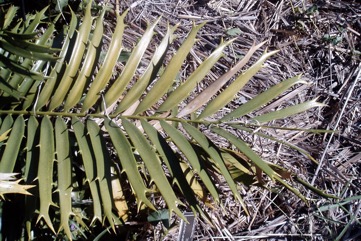
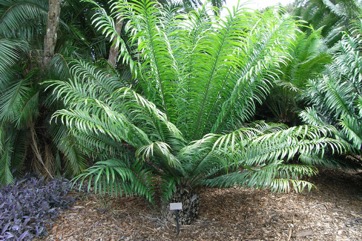
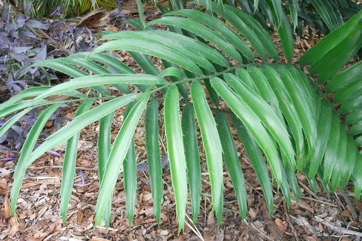
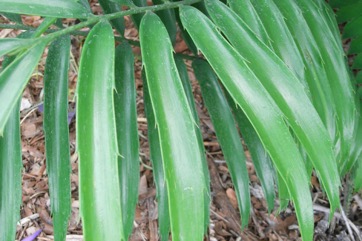
References
Burkill, I.H., 1966, A Dictionary of the Economic Products of the Malay Peninsula. Ministry of Agriculture and Cooperatives, Kuala Lumpur, Malaysia. Vol 1 (A-H) p 937
Cundall, P., (ed.), 2004, Gardening Australia: flora: the gardener's bible. ABC Books. p 536
Dale, I. R. and Greenway, P. J., 1961, Kenya Trees and Shrubs. Nairobi. p 2
Dharani, N., 2002, Field Guide to common Trees & Shrubs of East Africa. Struik. p 90
Etherington, K., & Imwold, D., (Eds), 2001, Botanica's Trees & Shrubs. The illustrated A-Z of over 8500 trees and shrubs. Random House, Australia. p 279
Facciola, S., 1998, Cornucopia 2: a Source Book of Edible Plants. Kampong Publications, p 247
http://www.fao.org/forestry/25323-096344a3de335832e8f363c3ac5184a66.pdf
HILDEBRANDT,
Index sem. hort. berol. 1874:18. 1875?
Jardin, C., 1970, List of Foods Used In Africa, FAO Nutrition Information Document Series No 2.p 15
Jones, D.L., 2000, Cycads of the world. Reed New Holland. p 197
Menninger, E.A., 1977, Edible Nuts of the World. Horticultural Books. Florida p 163
Pakia, M., 2000, Plant Ecology and Ethnobotany of two sacred forests (Kayas) at the Kenya Coast. M. Sc. Thesis.
Peters, C. R., O'Brien, E. M., and Drummond, R.B., 1992, Edible Wild plants of Sub-saharan Africa. Kew. p 7
PRAIN,
Ruffo, C. K., Birnie, A. & Tengnas, B., 2002, Edible Wild Plants of Tanzania. RELMA p 300
Sukarya, D. G., (Ed.) 2013, 3,500 Plant Species of the Botanic Gardens of Indonesia. LIPI p 828
THIERET,
Wickens, G.E., 1995, Edible Nuts. FAO Non-wood forest products. FAO, Rome. p179
WILLIAMS,
World Checklist of Useful Plant Species 2020. Royal Botanic Gardens, Kew